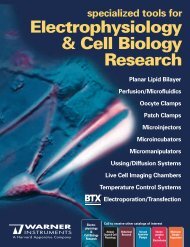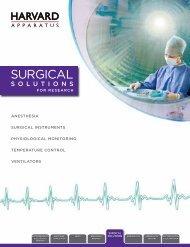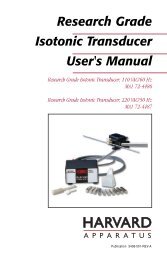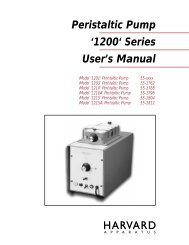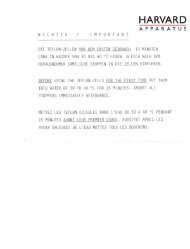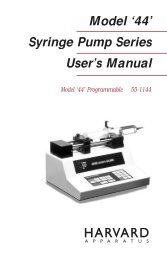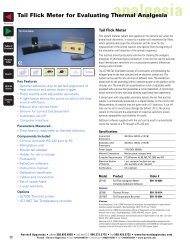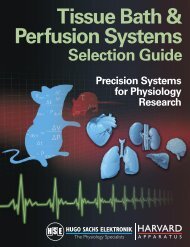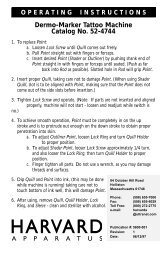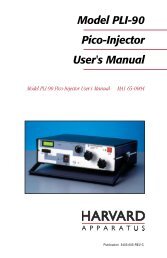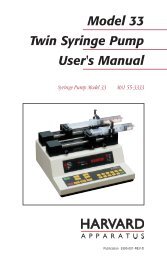to download the new 2011 Syringe Pump Catalog - Harvard ...
to download the new 2011 Syringe Pump Catalog - Harvard ...
to download the new 2011 Syringe Pump Catalog - Harvard ...
You also want an ePaper? Increase the reach of your titles
YUMPU automatically turns print PDFs into web optimized ePapers that Google loves.
How <strong>to</strong> Calculate <strong>the</strong><br />
Pressure Requirement of Your Experiment<br />
The following chart will help you determine <strong>the</strong> pressure requirement of your experiment. This is important in<br />
selecting <strong>the</strong> correct pump with <strong>the</strong> proper psi capability for your application. Choose <strong>the</strong> selections that are<br />
<strong>the</strong> closest <strong>to</strong> your experimental conditions or write in your actual values. Once you have filled in <strong>the</strong> chart call us<br />
for technical assistance if needed.<br />
1 Nature of <strong>the</strong> sample you are flowing in<strong>to</strong> (Application)<br />
2 The flow rate of <strong>the</strong> material<br />
3 The surface area of <strong>the</strong> syringe<br />
and <strong>the</strong> linear force capability of <strong>the</strong> pump<br />
4 The tubing diameter<br />
5 The tubing length<br />
6 Viscosity of <strong>the</strong> material being pumped<br />
7 The temperature of <strong>the</strong> material being pumped<br />
NORMAL PRESSURE<br />
0 <strong>to</strong> 30 psi<br />
(0 <strong>to</strong> 2 bar)<br />
HIGH FORCE<br />
31 <strong>to</strong> 150 psi<br />
(2.1 <strong>to</strong> 10.2 bar)<br />
EXTREME HIGH PRESSURE<br />
151 <strong>to</strong> 2000 psi<br />
(10.3 <strong>to</strong> 137 bar)<br />
1. Application<br />
L<br />
O<br />
W<br />
H<br />
I<br />
G<br />
H<br />
Flow in<strong>to</strong> open containers,<br />
i.e. titrations, food trays filling<br />
Inject in<strong>to</strong> Tissue,<br />
i.e. Drug infusion in<strong>to</strong> muscle, brain<br />
Flow in<strong>to</strong> closed container,<br />
i.e. Reaction Chamber 350 <strong>to</strong> 400 psi<br />
High viscosity solutions at high flow rates in a short period of time,<br />
i.e. Corn syrup<br />
2. FLOW RATE - <strong>Pump</strong>ing Speed (The faster <strong>the</strong> flow rate, <strong>the</strong> higher <strong>the</strong> pressure)<br />
0.003 µl/hr <strong>to</strong> 140 ml/min<br />
141 ml/min <strong>to</strong> 220 ml/min<br />
3. SYRINGE SIZE (<strong>Syringe</strong> volume/plunger area + linear force of pump)<br />
10 µl <strong>to</strong> 1 ml ie. 500 µl/min x 20 Lbs = 500<br />
4. TUBING SIZE (Inner diameter, Smaller ID = higher pressure)<br />
SMALL - Capillary (<strong>the</strong> longer more pressure)<br />
LARGE - Hose<br />
5. TUBING LENGTH - DISTANCE (Depends on ID Smaller ID = higher pressure)<br />
Short, < 1M<br />
Long, > 1M<br />
6. VISCOSITY OF MATERIAL TO BE PUMPED (Higher viscosity = higher pressure)<br />
AIR 18˚C = 0.0182 cP<br />
WATER 20˚C = 1.002 cP<br />
OLIVEOIL 20˚C = 84 cP<br />
PANCAKESYRUP 20˚C = 2500 cP<br />
HONEY 20˚C = 10000 cP<br />
PEANUT BUTTER 20˚C = 250000 cP<br />
7. TEMPERATURE OF SOLUTIONS BEING PUMPED (Higher temperature = lower viscosity = lower pressure)<br />
0 <strong>to</strong> 15°C<br />
15 <strong>to</strong> 80°C<br />
102 <strong>Harvard</strong> Apparatus phone 508.893.8999 <strong>to</strong>ll free U.S. 800.272.2775 fax 508.429.5732 www.harvardapparatus.com



